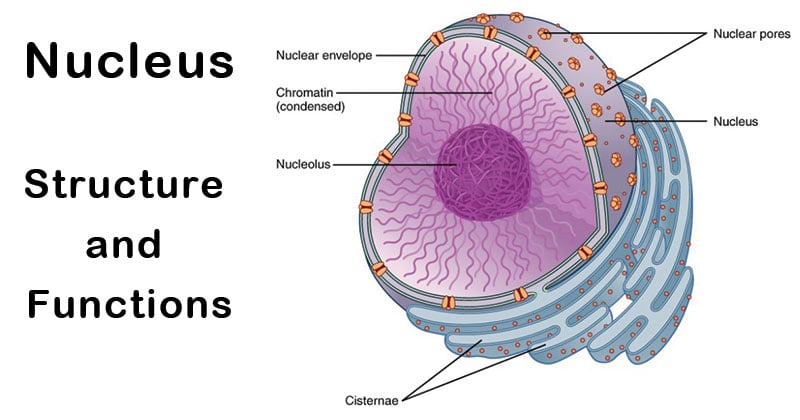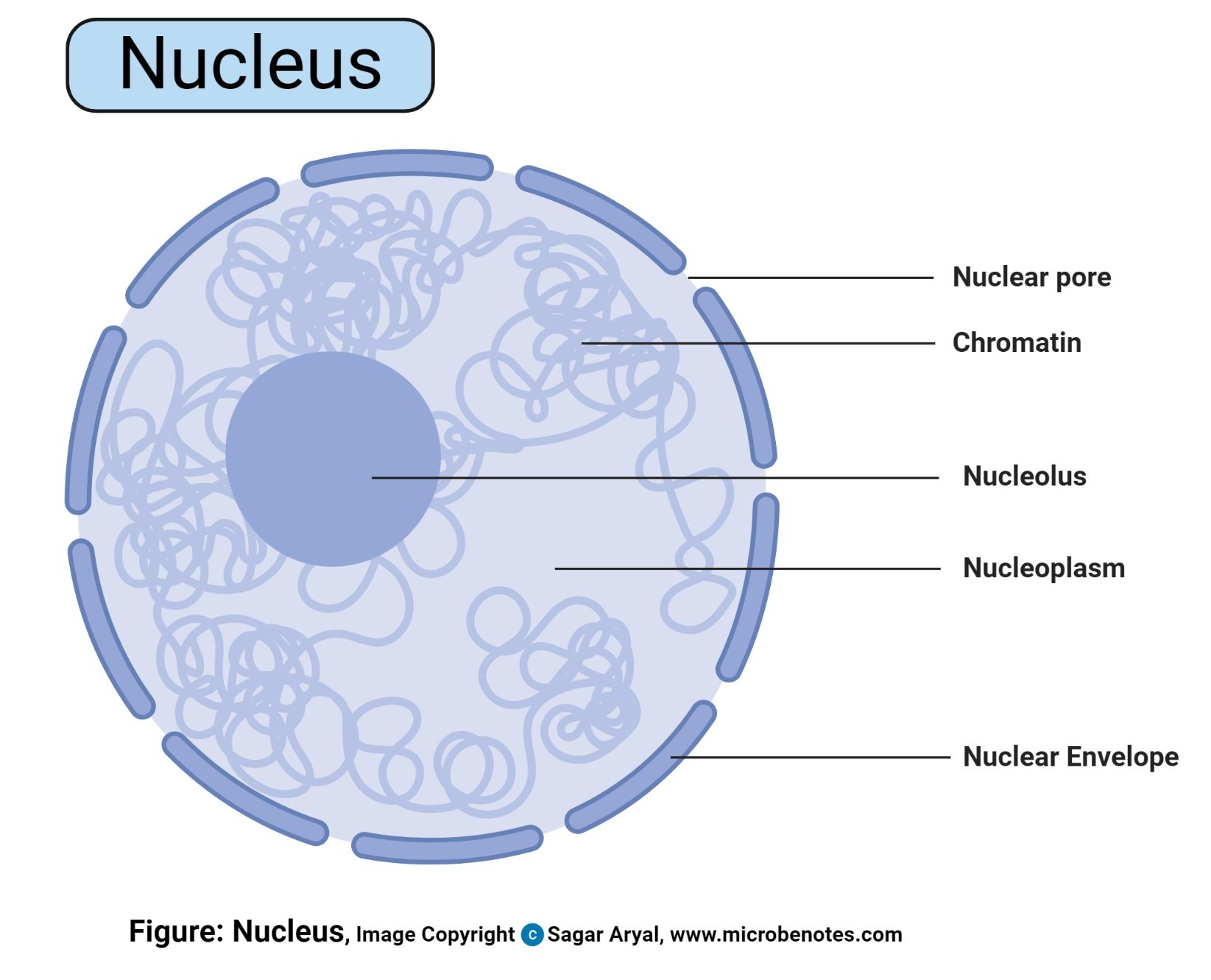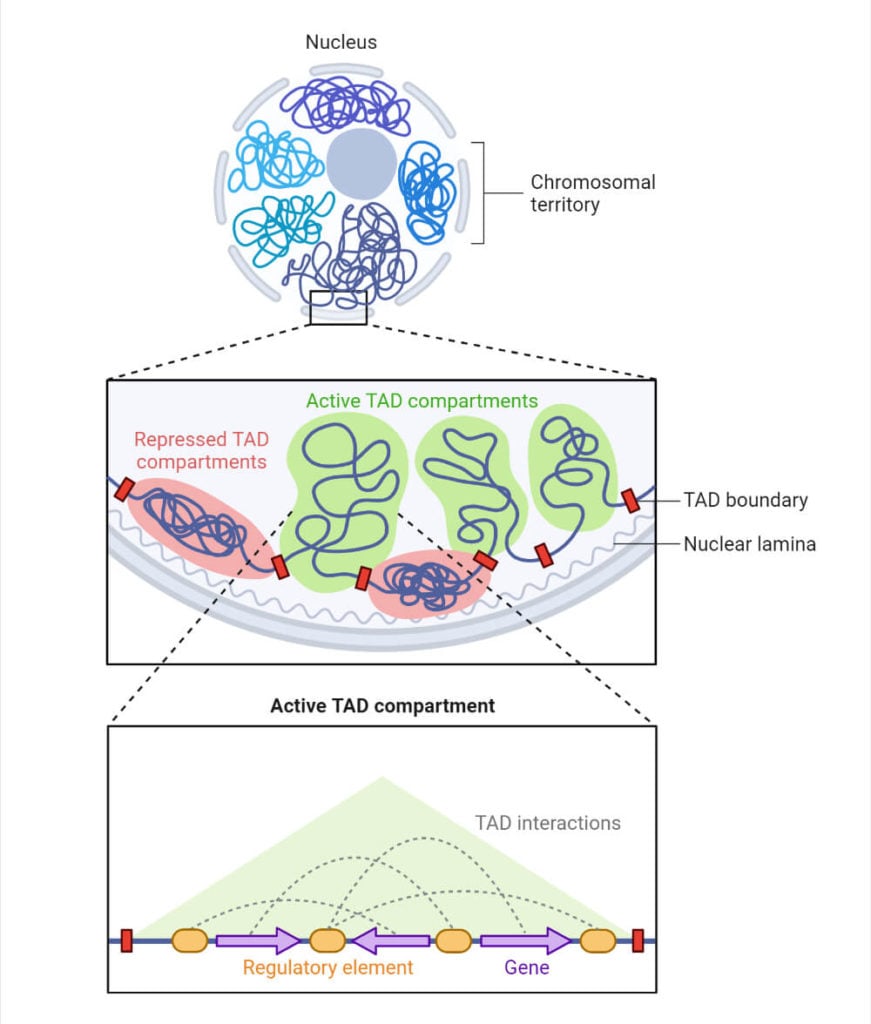Nucleus: Definition, Structure, Parts, Functions, Diagram

It is the command center of a eukaryotic cell and is commonly the most prominent organelle in a cell accounting for about 10 percent of the cell’s volume.
In general, a eukaryotic cell has only one nucleus. However, some eukaryotic cells are enucleated cells (without a nucleus), for example, red blood cells (RBCs); whereas, some are multinucleate (consists of two or more nuclei), for example, slime molds.
The nucleus is separated from the rest of the cell or the cytoplasm by a nuclear membrane.
As the nucleus regulates the integrity of genes and gene expression, it is also referred to as the control center of a cell.

Table of Contents
Interesting Science Videos
Nucleus Structure
The structure of a nucleus encompasses the nuclear membrane, nucleoplasm, chromosomes, and nucleolus.
Nuclear Membrane

- The nuclear membrane is a double-layered structure that encloses the contents of the nucleus. The outer layer of the membrane is connected to the endoplasmic reticulum.
- Like the cell membrane, the nuclear envelope consists of phospholipids that form a lipid bilayer.
- The envelope helps to maintain the shape of the nucleus and assists in regulating the flow of molecules into and out of the nucleus through nuclear pores. The nucleus communicates with the remaining of the cell or the cytoplasm through several openings called nuclear pores.
- Such nuclear pores are the sites for the exchange of large molecules (proteins and RNA) between the nucleus and cytoplasm.
- A fluid-filled space or perinuclear space is present between the two layers of a nuclear membrane.
Nucleoplasm
- Nucleoplasm is the gelatinous substance within the nuclear envelope.
- Also called karyoplasm, this semi-aqueous material is similar to the cytoplasm and is composed mainly of water with dissolved salts, enzymes, and organic molecules suspended within.
- The nucleolus and chromosomes are surrounded by nucleoplasm, which functions to cushion and protect the contents of the nucleus.
- Nucleoplasm also supports the nucleus by helping to maintain its shape. Additionally, nucleoplasm provides a medium by which materials, such as enzymes and nucleotides (DNA and RNA subunits), can be transported throughout the nucleus. Substances are exchanged between the cytoplasm and nucleoplasm through nuclear pores.
Nucleolus
- Contained within the nucleus is a dense, membrane-less structure composed of RNA and proteins called the nucleolus.
- Some of the eukaryotic organisms have a nucleus that contains up to four nucleoli.
- The nucleolus contains nucleolar organizers, which are parts of chromosomes with the genes for ribosome synthesis on them. The nucleolus helps to synthesize ribosomes by transcribing and assembling ribosomal RNA subunits. These subunits join together to form a ribosome during protein synthesis.
- The nucleolus disappears when a cell undergoes division and is reformed after the completion of cell division.
Chromosomes
- The nucleus is the organelle that houses chromosomes.
- Chromosomes consist of DNA, which contains heredity information and instructions for cell growth, development, and reproduction.
- Chromosomes are present in the form of strings of DNA and histones (protein molecules) called chromatin.
- When a cell is “resting” i.e. not dividing, the chromosomes are organized into long entangled structures called chromatin.
- The chromatin is further classified into heterochromatin and euchromatin based on the functions. The former type is a highly condensed, transcriptionally inactive form, mostly present adjacent to the nuclear membrane. On the other hand, euchromatin is a delicate, less condensed organization of chromatin, which is found abundantly in a transcribing cell.
Besides the nucleolus, the nucleus contains a number of other non-membrane-delineated bodies. These include Cajal bodies, Gemini of coiled bodies, polymorphic interphase karyosome association (PIKA), promyelocytic leukemia (PML) bodies, paraspeckles, and splicing speckles.

Nucleus Functions
The nucleus provides a site for genetic transcription that is segregated from the location of translation in the cytoplasm, allowing levels of gene regulation that are not available to prokaryotes. The main function of the cell nucleus is to control gene expression and mediate the replication of DNA during the cell cycle.
- It controls the hereditary characteristics of an organism.
- The organelle is also responsible for protein synthesis, cell division, growth, and differentiation.
- Storage of hereditary material, the genes in the form of long and thin DNA (deoxyribonucleic acid) strands, referred to as chromatin.
- Storage of proteins and RNA (ribonucleic acid) in the nucleolus.
- The nucleus is a site for transcription in which messenger RNA (mRNA) are produced for protein synthesis.
- During the cell division, chromatins are arranged into chromosomes in the nucleus.
- Production of ribosomes (protein factories) in the nucleolus.
- Selective transportation of regulatory factors and energy molecules through nuclear pores.





